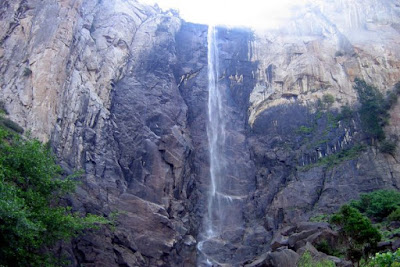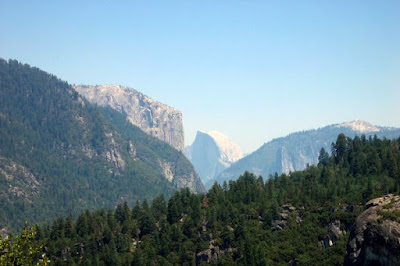
A Low Point in the Life of Ned and Joe
Friday morning we broke camp and headed for a last visit to the Yosemite valley. We made a quick stop at Bridalveil Fall though unlike the other falls we visited it was low on water. We stopped at the visitor center to stamp our park passport. I dropped into the Ansel Adams Gallery. It has works from local artists in addition to cards and posters of Ansel Adams original photographs. I bought Mary a pair of turquoise and silver earrings. We had lunch and headed out of the valley. On the way we passed two rescue helicopters getting ready to air lift two people out of the park near the base of El Capitain.

Bridalveil Falls

Our Last View of Half Dome and the Yosemite Valley
The plan was to drive down the eastern side of the Sierras stopping at Devils Postpile National Monument, Manzanar National Historic Site, Death Valley National Park and then drive to Las Vegas where Pap-pap was flying home. So we left Yosemite by the Tioga Pass Road a beautiful route that winds through north central Yosemite park topping out at 10,000 feet at Tioga Pass at the park's eastern entrance. We then turned south to Devils Postpile National Monument.
To get to Devils Postpile National Monument you have to have to take a shuttle from the Mammoth Mountain Ski Area. The shuttle was started to ease the amount of traffic entering the Valley. So we hopped on and sat back to let someone else drive.
The main reason Devils Postpile National Monument was created in 1911 was to protect and preserve the Devils Postpile formation. The Park Service's website has a good description of it, "The formation is a rare sight in the geologic world and ranks as one of the world’s finest examples of columnar basalt. Its columns tower 60 feet high and display an unusual symmetry ... The eruption and uniform cooling of basalt lava created an impressive wall of columns. Later a glacial event exposed the columns and polished smooth the top of this formation enhancing the pattern of hexagons that are a result of the mineral composition of the lava."
It was pretty neat. The base of the hill was covered in what looked like broken pieces of K'nex connector pieces. The boys and I did a quick hike to the top of the formation. We were running late when we arrived and the ranger station was closing but we managed to get Junior Ranger books. As we were leaving the boys caught up with a ranger and were able to receive their badges though the ranger seemed a bit put out. We hopped on the shuttle back to Mammoth Mountain. We stopped for dinner in Mammoth Lakes. It was really late when we arrived in Bishop, CA so we got a hotel room for the night.

Joe and Ned On the Top of the Postpile

The Devils Postpile

Ned and Joe Show Off Their Junior Ranger Badges
In the morning we continued south and very soon we reached Manzanar National Historic Site. In 1942, the United States government ordered more than 110,000 men, women, and children of Japanese descent to leave their homes and detained them in remote, military-style camps. Manzanar War Relocation Center was one of ten camps where Japanese American citizens and resident Japanese aliens were interned during World War II.
The Manzanar National Historic Site was established to preserve the stories of the internment of the Japanese Americans during World War II and to serve as a reminder of the fragility of American civil liberties. The visitor center and museum is in a building constructed by internees in 1944, which housed a gymnasium and a stage for plays, graduation ceremonies, and other social functions. It now holds moving exhibits of what life was like in the camp.
The camp covered a square mile and an auto tour describes the buildings that stood there. The most moving point on the tour is the cemetery. Although as many as 80 people were buried in the cemetery, only six remain today. In the cemetery is a white obelisk constructed by internee Ryozo Kado and dedicated in August, 1943. The inscription on the front of the monument translates, "This is the place of consolation for the spirit of all mankind." The inscription on the back says, "Erected by the Manzanar Japanese, August 1943."

Ned Learns How the Children Had to Borrow Toys in the Camp

"...the place of consolation for the spirit of all mankind."
Next, Death Valley National Park. We took California Route 190 into the park, a road that wound down hills to a flat straight road through the valley. We watched the outside temperature on the dash climb until it hit 111°. When we stopped at the visitor center at Furnace Creek the temperature was 126°. After the boys received their Junior Ranger badges we drove down to Badwater Basin. At 282ft below sea level it is the lowest point in the United States. The wind was so hot it felt like someone holding a torch to your face. We didn't stay long.
The most interesting thing to see at Death Valley was people doing anything in that heat. At Stovepipe Wells I noticed a ranger raking the gravel near the road because someone had driven over it. We also saw some people running. Every year there is an Ultramarathon but that was over a few days before. Stragglers?
Leaving Death Valley we made our way to Las Vegas. After checking into a hotel we went out eat and then cruised the Las Vegas Strip. We oohed and aahed over all of the lights. We didn't stay out to late. Pap-Pap's flight was leaving at 6:00 am so we had to be up early to get him to the airport.

The Road to Death Valley

The Boys Try to Hide From the Heat of the Wind at Badwater Basin

Las Vegas is also Home to New York, Paris and Venice

The Lights of Las Vegas

Yosemite National Park, CA to Bishop, CA, 166 miles 6 hrs 44 min

Bishop, CA to Las Vegas, NV, 313 miles 5 hrs 34 min



No comments:
Post a Comment